#acid mine drainage
Explore tagged Tumblr posts
Text






Douglas Falls on the North Fork of the Blackwater River is one of the loveliest of the many falls to be discovered in and around the Blackwater River Canyon. The falls is located adjacent to Douglas, West Virginia, an historic mining town about two miles from Thomas. The river here has suffered mightily from the acidic effluent of several abandoned mines nearby, leaving the streambed and boulders stained by "yellow boy" (iron hydroxide) in the AMD. Fortunately, the Friends of Blackwater has a number of mitigation and reclamation projects in progress that have already improved water quality. Eventually, the river's flow will scour away this awful legacy. The improvement in the river's health combined with the recent news that the lower part of the canyon will soon be in public ownership signal brighter days ahead for the watershed.
#appalachia#vandalia#west virginia#waterfall#fall#autumn#douglas falls#blackwater canyon#north fork of the blackwater river#acid mine drainage#reclamation#conservation#friends of blackwater
94 notes
·
View notes
Text
I do want to add too, that there are whole textbooks and companies and governmental bureaucracies dedicated to historic mining damage, lol. I've simplified it a whole lot. And this is an ongoing conversation- I think it's important for everyone to know the whole problem, which is: When you combine Water, Air, and Sulfuric Rocks, it creates acid.
Do we cap the landscape and plant acidic-tolerant plants so the slopes aren't exposed to air? Do we just keep this acid away from groundwater/people? Nuke the site so nobody goes there and nothing matters?
These are all valid options, said with varying levels of seriousness. But everyone brings something to the table, and at the end of the day, even IF "never mine anything ever" were an option, which it isn't, we'd still have to rectify our historic sins.
#ALSO worth pointing out that acid mine drainage is a misnomer because if you had sulfuric rocks at surface; and we did in#parts of the world - then this reaction happens there too! It's not just mine drainage it's a chemical reaction by the laws of physics#c'est la vie#mining#ptxt#apparently losing my mind tonight lol
4 notes
·
View notes
Text
Things Biden and the Democrats did, this week #21
May 31-June 7 2024
As part of President Biden's goal to bring the number of traffic deaths to zero, the Department of Transportation has sent $480 million in safety grants to all 50 states, DC, and all the US territories. The grants will focus on trucks, buses and other large vehicles. Thanks to DoT safety actions deaths involving heavy vehicles dropped by 8% from 2022 to 2023 and the department wants to keep pushing till the number is 0.
The Departments of Interior and Agriculture announced $2.8 billion plan to protect public land and support local government Conservation Efforts. $1.9 billion will be used to repair and restore national parks and public land, restoring historic sites, as well as Bureau of Indian Education-funded schools. $900 million will go to conservation funding, allowing the government to buy land to protect it. Half the funds will go to the federal government half to state and local governments and for the first time ever a tribal Conservation Land Acquisition program has been set up to allow tribal governments to buy land to protect nature.
The Department of Transportation announced that it had managed to get customers nearly $1 Billion dollars worth of flight reimbursements. The DoT reached an agreement with 3 airlines, Lufthansa, KLM, and South African Airways to pay between them $900 million to passengers effected by Covid related cancellations and delays. This adds to the $4 billion dollars of refunds and reimbursements to airline passengers under the Biden Administration.
The Department of Interior announced $725 million to clean up legacy coal pollution. This is the 3rd pay out from the $11.3 billion dollars President Biden signed into law in the Bipartisan Infrastructure Law to clean up coal pollution and invest in communities that used to rely on the coal industry. The money will be spent across 22 states and the Navajo Nation. Closing dangerous mine shafts, reclaim unstable slopes, improve water quality by treating acid mine drainage, and restore water supplies damaged by mining.
HUD launches the first of its kind investment program in manufactured homes. Manufactured homes represent a major market for affordable housing and the Biden Administration is the first to offer support to people trying to buy. HUD hopes the program will help 5,000 families and individuals buy their own home over the next 5 years.
The Department of the Interior announced $700 million for long-term water conservation projects across the Lower Colorado River Basin. The Colorado River Basin provides water for more than 40 million people, electric power to 7 US States and is a critical crucial resource for 30 Tribal nations and two Mexican states. The project hopes to save more than 700,000 acre-feet of water in Lake Mead. In the face of climate change causing a historic 23-year drought, there is record low water levels at Lake Powell and Lake Mead. The Biden Administration has moved aggressively to try to protect the Colorado River and make sure there's enough water in the West.
HUD makes $123 million for fighting Youth Homelessness available. This represents the 8th round of investment in Youth Homelessness since 2021 for a total of $440 million so far. The Biden Administration is focusing on innovative answers, like host homes, and kinship care models, with emphasis on creating equitable strategies to assist youth who are most vulnerable, including BIPOC, LGBTQIA+, and youth with disabilities. This is part of the Biden Administration goal of cutting homelessness by 25% by the end of 2025
The Department of Agriculture announced a series of actions to strength Tribal food sovereignty. The USDA will grant tribes in Maine, Alaska, Montana, Nebraska, North Carolina, Oregon and Washington $42 million through the Indigenous Animals Harvesting and Meat Processing Grants to support native animal harvesting. $18 million for projects under the Tribal Forest Protection Act. As well as $2.3 million to support the service of Indigenous foods in school meal programs. The USDA also plans its first ever class of interns specifically focused on Tribal agriculture and food sovereignty. The USDA also plans to host a first ever international trade mission focused on Tribal Nation and Native Hawaiian Community businesses.
Bonus: President Biden, First Lady Jill Biden, and Secretaries of Defense Lloyd Austin and State Antony Blinken traveled to Normandy France to mark the 80th Anniversary of D-Day. They were joined by a handful of surviving veterans of the landings many over 100 years old.
youtube
#Thanks Biden#Joe Biden#us politics#american politics#D-Day#housing#air lines#climate change#conservation#water#colorado river
411 notes
·
View notes
Text
Wound Care
Ok so, take this with a BIG grain of salt, because I may be a medical doctor BUT you need to know how much wound care training we get in medical school: none. Zip. Zilch. There may be medical schools where you do, but mine wasn't a bozo factory and there was NO wound care training. Everything I know I learned from one of several sources: an intensive 2-day wound care course I did in residency (highly recommend), the local Home Health wound care nurse (highly recommend), a completely batshit insane old white male doctor who started our learning sessions by yelling Vietnam War stories at me (do not recommend), a hospital wound care nurse (highly recommend), and experience (oh god do not recommend).
The first thing you need to know is that wound healing varies dramatically across the course of a lifespan. Kids? Kids will heal. If they don't, get their ass to a pediatrician because there's something genetic going on. Young adults will heal. Middle-aged adults will heal. You know who doesn't heal for shit? The elderly, and people with severe illnesses, and people with uncontrolled type II diabetes.
Your body needs several things in order to heal. It needs macronutrients, so you need to be able to EAT protein, fat, and carbs. If you are on total parenteral nutrition, aka TPN, aka IV nutrition, you are going to be worse at healing. If you are starving yourself, you are going to be worse at healing. If your body is desperately funneling all the calories you take in to surviving your COPD or cancer, you are going to be worse at healing.
It also needs micronutrients. If your diet sucks, you won't heal. Take a multivitamin once in a while.
There are two CRITICAL skin components to healing: collagen and elastin. Guess what we stop making as we age. Promoting collagen isn't just good for "anti-aging," it's good for NOT ripping your skin apart. Taking oral collagen is probably bullshit because your body is going to have to disassemble it to get it across the intestinal membranes to absorb, but it's also harmless, and if your diet REALLY sucks, who knows. Give it a try. Collagen is made of amino acids; think protein.
Another absolutely crucial component is blood flow. As people age, they start to develop cholesterol plaques lining arteries that eventually pick up calcium deposits. This makes blood vessels less elastic, which is a problem, but eventually also blocks them off, which is a much bigger problem. If someone has the major blood flow to their feet decreased by 90% by arterial stenosis, they are not going to heal for shit AND their foot's gonna hurt.
One component of blood flow I hadn't thought about before going into medicine is fluid retention. The way your body works, blood exits the heart at a very high velocity, but slows to a crawl by the time it gets into capillaries, the smallest blood vessels in the body. Water is a very small molecule and can leave the blood vessel, especially if there aren't big, negatively-charged molecules like proteins like albumin in the blood vessels to hold the water there. And we're built for this--some water is supposed to leak out of our blood vessels when it gets to real little vessels. It gets taken back up by the lymphatic system and eventually dumped back into the bloodstream at the inferior vena cava. But if you aren't making albumin--for instance, in liver failure--you may leak a LOT of fluid into the tissue, so much that your legs get swollen, tight, the skin feeling woody and strange. This isn't fixable by drainage because the fluid is everywhere, not in a single pocket we can drain. And because it puts so much pressure on the tissues of the skin, it often results in ulcers. Congestive heart failure, liver failure, kidney failure--these are all common causes of severe edema, aka swelling due to fluid in the tissues. And they're a real bitch when it comes to wound care, because we have such limited resources for getting the fluid back out, which is a necessary first step to healing.
Pressure is another common cause of wounds. Pressure forces blood out of those little capillaries, so you starve the cells normally fed by those capillaries, and they die. It's called pressure necrosis. Very sick people who can't turn themselves over--people in the ICU, people in nursing homes--are especially prone to these wounds, as are people with limited sensation; pressure wounds are common in wheelchair users who have lost some feeling in the parts of their bodies that rub against those surfaces, or diabetics who don't notice a rock in their shoe.
So, if you're trying to treat wounds, the questions to ask are these:
Why did this wound happen?
-Was it pressure? If it's pressure, you have to offload the source of the pressure or else that wound will not heal. End of story. You can put the tears of a unicorn on that thing, if you don't offload the pressure it won't heal.
-Was it fluid? If it's fluid, you have get the fluid out of the issues or else it won't heal. You can sometimes do that with diuretics, medications that cause the body to dump water through the kidneys, but that's always threading a needle because you have to get someone to a state where they still have juuuuust enough fluid inside their blood vessels to keep their organs happy, while maintaining a very slight state of dehydration so the blood vessels suck water back in from the tissues. You can use compression stockings to squeeze fluid back into the vessels, but if they have arterial insufficiency and not just venous insufficiency, you can accidentally then cause pressure injury. The safest option is using gravity: prop the feet up above the level of the heart, wherever the heart is at, at that moment, and gravity will pull fluid back down out of the legs. Super boring though. Patients hate it. Not as much as they hate compression stockings.
-Was it a skin tear because the skin is very fragile? This is extremely common in the elderly, because they're not making collagen and elastin, necessary to repairing skin. If this is the case, make sure they're actually getting enough nutrition--as people get into their 80s and 90s, their appetites often change and diminish, especially if they're struggling with dementia. And think about just wrapping them in bubble wrap. Remove things with sharp edges from their environments. I have seen the WORST skin tears from solid wood or metal furniture with sharp edges. Get rid of throw rugs and other tripping hazards. I had somebody last week who tried to a clear a baby gate and damn near destroyed their artificial hip.
The next critical question: why isn't it healing?
-Are you getting enough nutrients? Both macro and micro?
-Are you elderly?
-Are you ill?
-Do you have a genetic disorder of collagen formation?
Fix why it's not healing and almost anything will heal. If you're diabetic, find a medication regimen that improves your sugars and stick to it. If you're anorexic, get treatment for your eating disorder. If you have congestive heart failure, work with your doctor on your fluid balance. Wear the damn pressure stockings. Prop up your feet.
If, after those two unskippable questions are done, you want to do something to the wound--apply a dressing, do a treatment--that's a whole other kettle of fish. I'll write that later. The dryer just sang me its little song and I need to put away the laundry.
1K notes
·
View notes
Photo
This is the combination of natural and man-made factors. The “cave” here is an abandoned mine, as rainwater leached in it dissolved the minerals here to create the hellscape we see. Also quite the unpleasant sign for the poor schmucks downriver.

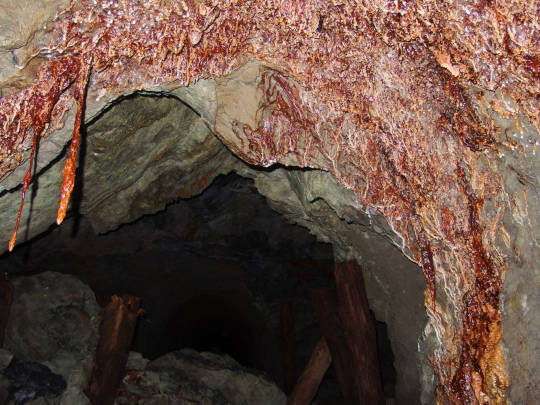

limonite mud and stalactites
-J.F.
19K notes
·
View notes
Text

Book Rec - Land Healing by Dana O'Driscoll
For anyone looking to cultivate a deeper relationship with their local land spirits or to engage in more active stewardship of their local biome, I'd like to recommend Land Healing by Dana O'Driscoll.
A follow-up to her other fabulous book, Sacred Actions, Land Healing is a comprehensive guide to land healing for neopagans and earth-based spiritual practitioners who have a desire to regenerate and heal human-caused damage throughout our world. The book presents tools and information to take up the path of the land healer with care, reverence, and respect for all beings. This book also puts tools in your hands to be an active force of good and learn how to actively regenerate the land, preserve life, and create sanctuaries for life–in your backyard, in your community, and beyond.
Dana O’Driscoll has been an animist, and bioregional druid for 20 years and currently serves as the Grand Archdruid in the Ancient Order of Druids in America. She is also a druid-grade member of the Order of Bards, Ovates and Druids and is OBOD’s 2018 Mount Hameus Scholar. Dana took up the path of land healing because of the deep need in her home region of Western Pennsylvania, which is challenged by fracking, acid mine drainage into streams, logging, and mountaintop removal. Dana sees land healing as her core personal spiritual path, and has done both individual work in her home region as well as spearheading larger-scale land healing efforts at druid events and through the Ancient Order of Druids in America. Dana is a certified permaculture designer and permaculture teacher who teaches sustainable living and wild food foraging. She lives on a 5-acre homestead with her partner and a host of feathered and furred friends.
You can find out more about her practices and her publications by visiting The Druid's Garden and you can also hear more on this recent episode of Hex Positive, where Dana talks about her newest book and the inspiration behind it.
#witchblr#pagan#druidry#book recs#green witchcraft#witchy things#Land Healing#Dana O'Driscoll#Spotify
146 notes
·
View notes
Text
And I said it with a straight face
Son: Maybe you could go out with me this weekend to drive around the coal-mining region and look for evidence of old, closed mines! In the snow!
Me: Uh . . Well, of course, Honey, I'd lo ve to.
Him: Look! Last weekend I found several sites with acid mine drainage! I have pictures!*
Me: Gosh! Wow!
'* This is exciting to him because he is mixing his fishing and mining passions into a DEEP desire to participate in large stream reclaimation projects to make streams healthy again.
59 notes
·
View notes
Text

Facts and Theories related to Fool's Gold and Norton
Part 1: Facts and Theories about Pyrite aka Fool's Gold
TLDR - Facts:
comes from the Greek word for fire
the dangers of pyrite oxidation (sulfuric acid, sulfur dioxide)
pyrite can contain small amounts of real gold, called “invisible gold”
TLDR - Theories
Pyrite containing real gold parallel to Norton being good deep down
Fire connection to Infernal Sin
Pollution in Lakeside water and soil as well as cause of fish and plants dying because of Golden Cave?
Part 2: Facts and Theories about how Norton escaped Golden Cave
TLDR:
Norton didn't just simply dig himself out
Facts about mines, mine collapses, dangers, potential escape routes, etc...
Part 1
Facts
Pyrite (aka fool’s gold) comes from the Greek word ‘pyros’ meaning ‘fire’, and will create sparks when struck against metal or a hard surface.
It is capable of scratching glass while most knives won’t be able to scratch it.
In the presence of moisture and oxygen, pyrite oxidizes, releasing its sulfur content as sulfuric acid.
Pyrite rich waste from mining operations can increase acidity of surface water. This can harm downstream ecosystems, animals, and even pose a risk to humans.
Sulfur dioxide is produced by burning the pyrite in coal, which can combine with moisture in the atmosphere to create acid rain.
Pyrite oxidation is sufficiently exothermic enough to produce heat, and as the temperature rises, the coal heats up and in some cases cause it to self-ignite and cause fire. This is called spontaneous combustion, a very real problem in coal mines. Pyrite dust can burn even with only a little oxygen, and it burns well due to its sulfur content. Sulfide fires can burn for years.
Despite its reputation, pyrite can sometimes contain small amounts of real gold, although it is notoriously hard to extract. This gold is sometimes referred to as “invisible gold” because it isn’t observable by the naked eye or standard microscopes (you need sophisticated scientific instruments). It can come in different forms: either as particles of gold, an alloy where the pyrite and gold are finely mixed, and in defects (imperfections created when the pyrite crystals are forming) in the crystal structure . With the latter form, the more deformed it is, the more gold there is in the defects.
And the discovery of new gold deposits declining world wide, with the quality of ore degrading in parallel to the value of precious metal increasing.
Invisible gold is primarily found in pyrite and arsenopyrite, and this is now a common resource for the gold mining industry.
Theories
I really wanted to bring up pyrite having some real gold (even if the amounts are very small). Especially as I can draw a parallel with that to Norton, who may normally seem suspicious, but he isn’t entirely bad. He may seem unapproachable, but you may make progress if you dig deep enough and try hard enough. He isn’t completely “worthless”.
Pyrite coming from the word for fire connects well to Infernal Sin, while pyrite being a fire starter in the fast due to its ability to create sparks fits well with Norton’s how we see Norton causing the explosion in Golden Cave in his trailer.
Then regarding the sulfuric acid, this actually made me wonder if the contamination in Lakeside, revealed in Yidhra’s letters, could be related to or from Golden Cave.

Ground water is water that seeps into the ground via rain or snow melt. As it makes its way underground, it can collect or react to the minerals and rocks down there, including pyrite, which can eventually result in the oxidation (and all its problems) I described earlier. This can percolate to form sediment at the bottom of rivers with mine drainage, which is water drained from mines. Acid runoff further dissolved heavy metals into water, and acid mine drainage can be increased by the action of certain bacteria (aka, sulfuric acid from pyrite can leech heavy metals from rock, and the acid can be worsened by bacterial action, resulting in this drainage becoming highly toxic).
Problems with mine drainage include contaminated drinking water, disrupted growth and reproduction of plants and animals, and corroding effects of acid on structures.
In general, sulfide rich and carbonate poor materials produce acid drainage. In contrast, alkaline rich materials, even with significant sulfide concentrations, often produce alkaline conditions in water.
Abandoned mines can fill with water (flood) because there’s no pumping occurring (the steam engine was 1st invented to solve mine flooding). This results in unabated chemical reactions, potentially making it very toxic, and this water can even discharge into lakes and streams, killing aquatic life and polluting the environment.
Further acid drainage can result from waste rock, which is material that must be removed to reach the ore. It is often deposited in piles close to the mine, and as it is exposed to air and moisture, it causes weathering, which can generate acid drainage.
Yidhra’s 3rd letter does mention “microbial deposits” in the water and soil as well as the soil’s “acidity and alkalinity”. So maybe it could be connected…?
Part 2
Thoughts regarding specifically how Norton escaped Golden Cave
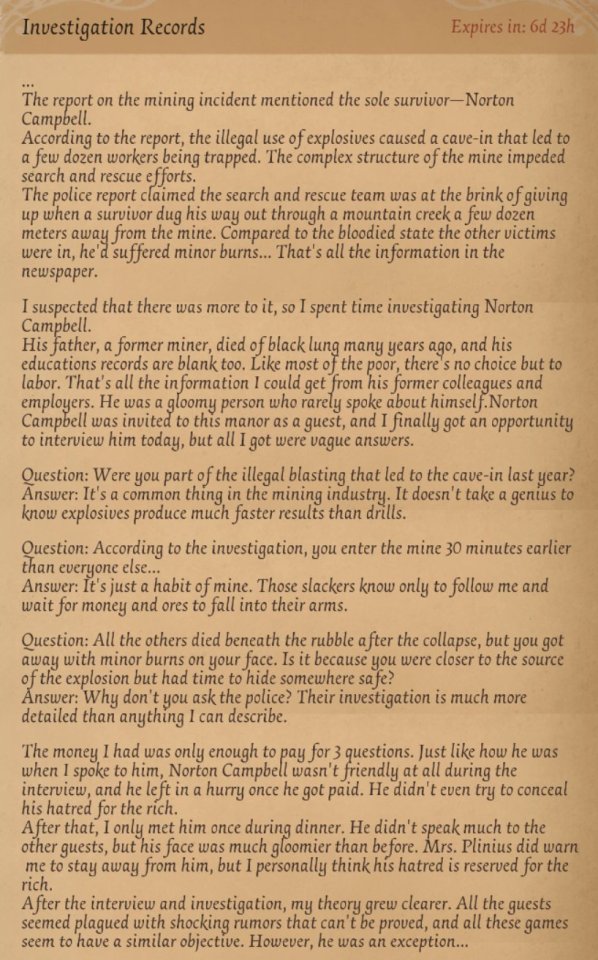
Norton’s 3rd letter states the police report claimed Norton “dug his way out through a mountain creek a few dozen meters away from the mine”.
It is unlikely Norton simply dug himself out from the mine.
Golden Cave’s backstory states it was “hundreds of meters” deep at least. Mines back in that day (late 19th century) were already 1000s of feet deep (1 was 700-900m = 2300 – 3000ft). Prior to the 1850s, miners could simply walk in to a mine to get where they needed to go, but later on, the mines became so deep, they had to use steam elevators to enable access to deeper seems.

We know Norton was trapped in Golden Cave for some time after the mine collapse considering we know he came out with meteorite chunks. Based on what we see on the lowest level of Golden Cave in game, this likely implies the meteorite was potentially at the bottom, meaning there’d be quite some distance to dig himself out.
The other issue is most miners don’t simply dig themselves out after a collapse. There’s nothing to support the roof and sometimes little space to put the material you remove, not to mention usually a lack of suitable tools. Trying to dig yourself out of a collapsed mine may even weaken the area near the collapse, potentially causing further collapses. This is why most miners usually have to wait to be rescued.
It is possible that Norton was able to access an alternate escape route. Mines were required to have more than 1 shaft following the Hartley mine disaster in 1862. If it or a raise (vertical or inclined passage) had a safety ladder, it’s possible he could work his way back up. During the Barnes-Hecker mine disaster (the mine was flooded), the sole survivor saved himself by climbed 80 stories (around 800 feet) in just about 14 minutes.
Another option is via an intake airway (or downcast shaft), which brings fresh air from the surface into the underground mine. Miners could feel the air to figure out a way out of the mine, and this was breathable air, free from fumes and dust in the case of a fire or explosion. A return airway (upcast shaft) is also an option, but not as nice of one due to the fact it carried air out of the mine to the surface, and this air could include dust, toxic fumes, and such. But miners have escaped via vents before (such as in the Quecreek Mine disaster, which they did to escape the mine as it started flooding).
And if acid mine drainage is potentially related to the pollution and dead animals/plants in Lakeside (Yidhra’s 3rd letter, Grace trailer/deductions), maybe that means there was drainage or some other hole into or out of the mine around there that Norton could’ve used to escape. Norton’s deduction 9 does make it sound like police didn’t expect anyone to survive, which could imply the normal entrances or exits were inaccessible following the collapse, meaning using an alternate, less known route might make sense. We know Norton was knowledgeable, and in the trailer we see him with a map, though based on how his coworkers in that scene look like they might take it from him, he might not have had that, but he may have at least memorized the different ways in and out, and thus how he could manage to escape (especially as explosions can damage the lifts they use to normally get down to the deeper levels).
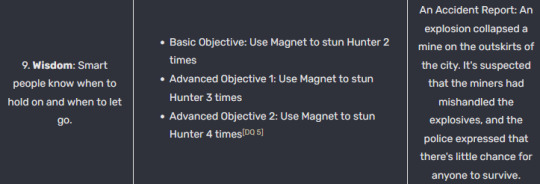
Norton likely survived due to being some distance from the blast. Some of his coworkers likely died from the initial explosion. The others potentially could’ve succumbed to lack of oxygen, potentially aided if any fires started as a result (which could further weaken supports or cause more collapses), or due to potentially high concentrations of firedamp further down. Afterdamp (choking gas) is a mix of toxic gases (carbon dioxide, carbon monoxide, and nitrogen) after a methane explosion, and it is just as deadly as the actual explosion. Symptoms include head swimming/disorientation, feeling very tired, difficulty doing anything or exerting yourself, and a desire to just close your eyes and go to sleep (followed soon by death from the lack of oxygen).
#idv#identity v#norton campbell#prospector#idv norton#identity v norton#idv prospector#identity v prospector#Fool's Gold#hunter norton#idv fool's gold#idv hunter norton#identity v fool's gold#identity v hunter Norton#sirenjose analyses and theories
78 notes
·
View notes
Note
Ask game! Share 5 boring facts about yourself and pass it on to someone else 😁
(No pressure)
01. I regularly say 6+4=14 and no I do not know why
02. I own approximately 7 comics bc I'm broke
03. my second favorite color is acid mine drainage orange
04. I bought a fidget spinner for 5 bucks when I was like nine and then lost it a week later and it's disappearance still haunts me
05. I think dinosaurs and weather patterns r cool
21 notes
·
View notes
Text

self portrait of the artist standing in an acid mine drainage tailings pile in socks
16 notes
·
View notes
Text

Acid mine drainage. Wellston, Ohio. April 18, 2025.
#mine#photography#nature#pollution#rust belt#appalachia#appalachain gothic#ohio#southeast ohio#mining#history#industrial
8 notes
·
View notes
Text
I don't want to respond to the direct post, 1) because the vote is over and it passed, 2) because I don't feel like being thorough about my commentary which means asking friends of friends at the site and looking up papers and permits. But holy cow, it keeps popping up on my dash.
1) Copper mines do not produce toxic waste. If anyone is telling you this, they're lying to you or stretching the truth, max.
1.2) If you leave a hole in the ground alone for long enough, the sulfides in the rock oxidize and produce an acid that leaches metals. That's what they're talking about. This does not happen to active mine sites because the water in the tailings/waste is reused and must be near-neutral. Calcium is also added to neutralize the acid. When the mine is shut down, when properly closed, all surfaces are covered so this oxidation can't take place.
2) Mining on the Michigan peninsula is one of the few places we have records of pre-Columbian copper use because the copper is in native form. It's very disingenuous of them to not mention this. See here.
3) Tailings dam specifications are built with geology in mind. They're huge. I don't think people understand how big (or small) they actually can be. But essentially, the engineering specs reflect the regional qualifications of the dam. A 100-year flood build design likely reflects the overall dam but not a location near a drainage basin which would be certified to higher spec. I worked at a mine that was near a fault and the qualifications were 1.2+ factors of safety over the shake potential for that kind of fault zone. Which is how it works for all engineering designs. The design plans would not have gotten this far in the USA without three licensed engineers looking at the plans.
Anyway. Don't lie to people right over my salad. It's absolutely okay not to want a mine in your backyard. There are actual reasons to get up in arms if you feel that way. But lying to people is not the way to do it.
#mining#industrial#ptxt#Sorry this just keeps popping up on my dash driving me nuts.#/anyway/ moving on lol
14 notes
·
View notes
Text
Excerpt from this press release from the Department of the Interior:
The Department of the Interior and the Office of Surface Mining Reclamation and Enforcement (OSMRE) today announced more than $244 million in fiscal year 2024 funding from President Biden’s Investing in America agenda to address dangerous and polluting abandoned mine lands, create good-paying, family-sustaining jobs and catalyze economic opportunity in coal communities across Pennsylvania. This is the largest annual state allocation under the Abandoned Mine Land (AML) program and is funded from the once-in-a-generation investment of $11.3 billion in AML funding provided by the Bipartisan Infrastructure Law.
Communities once powered by the coal industry are now polluted by abandoned mine lands, which leach toxic discharge into lands and waterways, cause land subsidence and structural issues, and fuel underground mine fires. This funding will ensure that coal communities are not left behind, but rather are revitalized by the jobs created for displaced coal workers, economic opportunity, and clean air and water provided by these cleanup projects.
Funding from the Bipartisan Infrastructure Law is expected to address nearly all of the currently inventoried abandoned coal mine lands in the nation, which will help communities address and eliminate dangerous conditions and pollution caused by historic coal mining.
Today’s announcement builds on more than $489.7 million from President Biden’s Investing in America agenda allocated to Pennsylvania for AML reclamation in fiscal years 2022 and 2023. Funding will be awarded to additional eligible states on a rolling basis as they apply.
AML reclamation supports jobs in coal communities by investing in projects that close dangerous mine shafts, reclaim unstable slopes, improve water quality by treating acid mine drainage, and restore water supplies damaged by mining. Awards can also enable economic revitalization by reclaiming hazardous land for recreational facilities and other redevelopment, such as advanced manufacturing and renewable energy deployment. As directed by the Bipartisan Infrastructure Law, funding will prioritize projects that employ current and former employees of the coal industry.
9 notes
·
View notes
Note
Hello, I was reading through your posts and couldn’t help but be inspired for a fictional material by some minerals and metals having an effect on the surroundings. If it’s not a chore, could you please provide any real world examples of how some minerals have effect on the environment. Something like affecting the structural integrity of, dyeing, or any other effects on the surrounding rock. Apologies if the question is not well worded or I’ve made an incorrect assumption, I know nothing of geology myself :)
Boy, I am so ridiculously happy you asked me that! It is one of my more favorite subjects! I will break this up into three sections, first to talk about environmental effects (this will include ideas of like mountain shapes, natural disasters, contamination of water, and even how streams look), then we will talk a bit about industry (what minerals are used for what, and how do they effect the people using them), then I will talk briefly about infrastructure before directing you to a documentary series that is old but does in fact explain all of this far better than I ever could hope to. This is kind of an extension of my economic trade and mining posts, so I will try to talk about similar but not the same topics! I feel like for the best results they should all be read together!
Environment: Some minerals that occur naturally are incredibly unstable at the surface, and when they breakdown it can really harm the environment. I am originally from Pennsylvania and a big problem in that area was something called Acid Mine Drainage, which is, in the simplest words, when sulfide minerals (in PA's case, pyrite) break down and lower the pH of the soil and water. This effectively kills most things living in the environment and can even be strong enough to cause skin irritations.
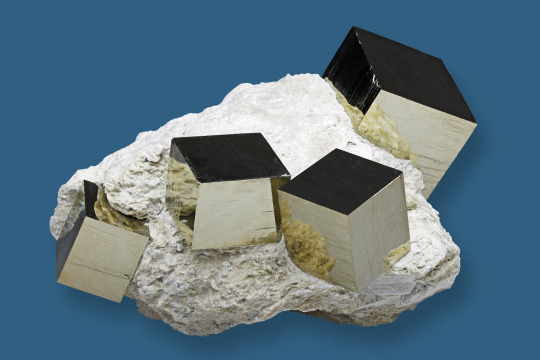
A great idea in a fictional world may be an old mining district that was abandoned and rediscovered with toxic water.
Something else that is small and thought about much less probably is something that happens when you boil water. If you pull well water (or groundwater) and boil it something that you may notice is a white ring form around your pots and pans. This is because your soil or rocks have access calcium and when you boil your water it precipitates out. This is not harmful, but it is something that will vary based off locations, and could effect ones health in a positive way (calcium is a very important nutrient).
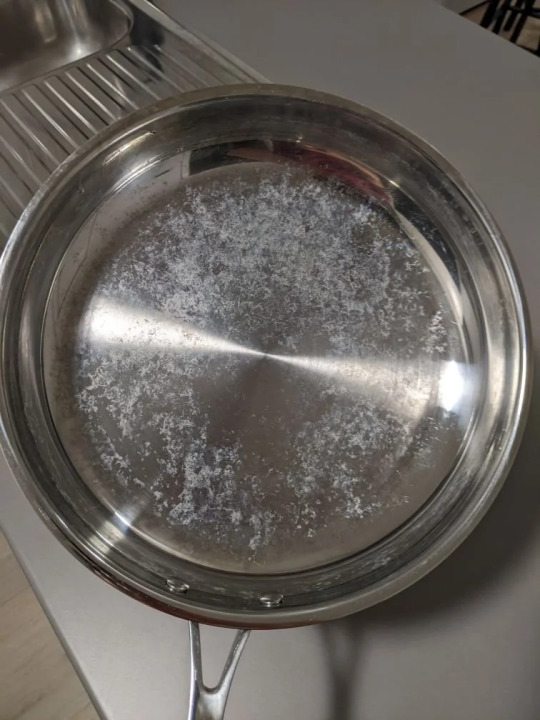
But taking a step back from human health, lets look at large scale differences that can be effected by minerals/different types of rocks
The first thing to consider is how can a landscape look? typically when you have metamorphic(excluding schists) or intrusive igneous rocks (granite and whatnot) typically you will see doming, well-rounded mountains vs. sedimentary rocks where you might see distinct layering as some layers are more soft than others.
More mountainous locations, regardless of rock type will have more braided rivers, and places that have lower elevation change will be more meandering rivers. The bottom of the riverbed also changes! in older mountain ranges you would expect to see more metamorphic rocks exposed to the surface as the top of the mountain range has already been eroded, while fresh new mountain ranges might have a larger diversity of rocks within the river. Something I distinctly remember from going to North Carolina for the first time was seeing all the glittering mica in the creek beds there because the Appalachians are a very old mountain range.
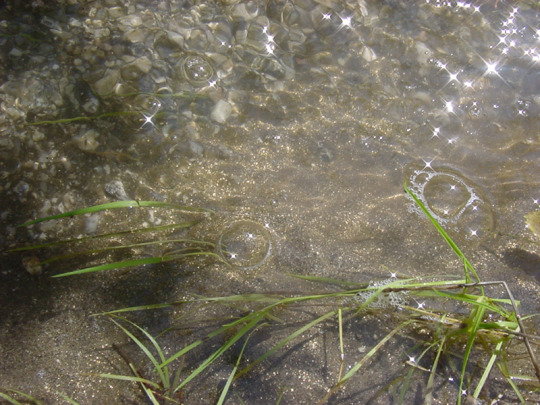
Always remember: The rocks in the river reflect what is in the mountain!

But how can this effect how does this effect people? crystalline rocks are typically safer mountains to live in than sedimentary rock mountains, because they have very little variation and are less likely to break across planes of weakness, that said they are usually poorer in resources for older time periods other than for making things like stone for building houses and harvesting silica to make glass. There are of course exceptions to this, but for the most part this is true.
Sedimentary rocks mountains on the other hand are more dangerous in causing landslides and sinkholes, however they are usually rich in resources like clay, coal, oil, and even in some causes be rich enough in metals to be mined for iron. Chert is also a sedimentary rock that is used a lot in Native American cultures to make arrowheads, spearheads, and basic cutting tools, though this is way out of my realm of knowledge.
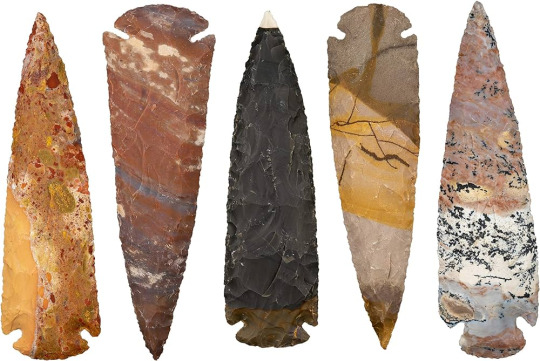
Industry: I have already hinted at some of these but I will try to talk purely about different things in this section! First lets talk about lead, my Roman empire is the Roman empire collapsing due to lead poisoning. Galena, a lead sulfide, is a rock formed in some sedimentary rocks and in hydrothermal environments (hot water injecting into cold rocks), hydrothermal activity can be present in past volcanic environments, during metamorphism, or even on the ocean floor. These are accessible in many locations is what I am trying to say, and lead is VERY appealing until you know it poisons you. It has a very low melting point meaning it is easy to work with, it is resistant to corroding, and it even imparts a sweet flavor and was used during the Roman empire to sweeten food without the addition of sugar or honey. Later, it was used due to its white color to make one look paler than they truly were because staying inside was a status symbol, added to glass to lower the melting point and increase the time it could be 'worked with' and the added side effect was that it made glass more shiny which then made it popular in jewelry. Lead was also used in paints, and dozens of other things, but it is time to move on.
Lets talk about paint colors that were available based on rocks! Clays and sedimentary rocks typically contained red to yellow hued pigments (think rust and earthy tones), so those colors would be seen more in art in areas dominated by sediments than say, green (unless there is a plant that can produce a strong enough pigment). Metamorphic rocks/hydrothermally altered rocks are more likely to produce colors like greens and blues and vibrant reds. What creates these colors is usually copper and mercury will create vibrant reds.
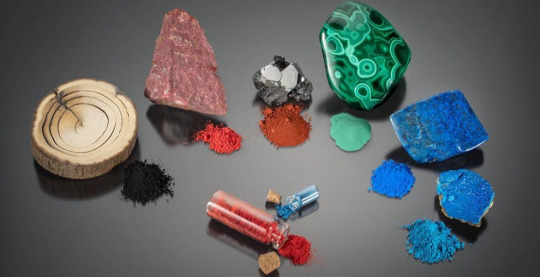
Scheele's green was a popular green that was created by an arsenic-bearing mineral that killed many people during the Victorian era.
Let's also briefly talk about how rocks could effect cosmetics! glittery eyeshadows, highlighter and other things we use today often use the mineral mica, which is a metamorphic mineral. It stands to reason that having shimmery makeup trend would be more likely in places that could supply it. Chalk could also presumably be used as a cosmetic which is a sedimentary rock, so maybe they could value matted and paler looks?
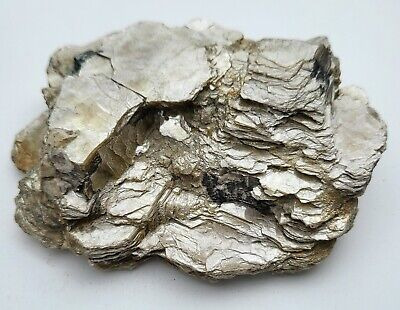
Another random thing that I have been dying to mention but couldn't think about a post it would fit in but imagine asbestos clothes that was a thing! Obviously people didn't know that it was bad for you at the time, and it seemed a miracle because it would be unaffected by fire and it was FABRIC made from ROCKS. Again, this is only found in places where asbestos is found, so like low temp metamorphic mafic/ultramafic rocks (essentially take the ocean floor and heat it up a little and BAM asbestos).
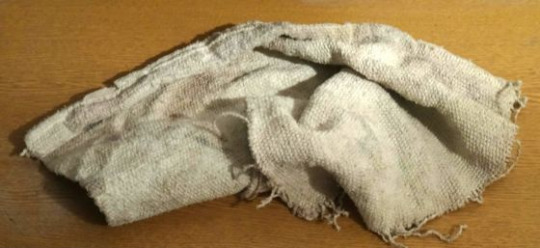
anywayyyyy, I truly truly believe the results are endless in this regard. I know very little in terms of history, so I am sure there are many others that can add to this in a very significant way.
Infrastructure: This one is probably the most obvious, but in terms of strength in building, different rock choices will be chosen. There is a reason marble is used to make pillars. Though the general rule of thumb is that massive rocks are generally more resilient to breaking, this includes sandstone for sedimentary rocks, granites/diorites/gabbros for igneous rocks, and marbles and quartzites for metamorphic rocks. Foliation or layering in a rock can also be abused like using slate for shingles and chalk boards and schist also for roofing.
The documentary that talks about most of these things: Journey to the Centre of the Earth: Art and Journey to the Centre of the Earth: Architecture. It is an older documentary series but I genuinely love Ian Stewart and all of his geology documentaries. You can also find both of these for free on YouTube I strongly recommend you find a legal version of this!
Anyway sorry for replying late my work has been piling up lately! Feel free to ask anymore questions! Also I didn't proofread this so if there is any grammar issues I am sorry.
28 notes
·
View notes
Text
Dionaea Muscipula

Dionaea muscipula, or the Venus flytrap, is one of the most well-known carnivorous plants in the world. It is native to eastern North America, particularly the United States, and grows primarily in moist, nutrient-poor areas such as swamps and wetlands. The Venus flytrap is special because of its unique method of preying, which is a "trap" in the trap.
The Venus flytrap is a small plant whose leaf tips form special "traps." The traps resemble sails with teeth, and they have sticky hairs on their inner surface. When prey, such as an insect, touches these hairs, the trap quickly closes, trapping the prey in the trap, and the plant can then close it completely.
The Venus flytrap specializes in preying on insects and small invertebrates that are not very large.In the wild, Venus flytraps grow primarily in wetlands, marshy areas, and other nutrient-poor soils where the soil is acidic and low in nitrogen and phosphorus. This nutrient deficiency is one reason why the plant has evolved to prey on animals – to obtain nutrients that the soil cannot provide.
The Venus flytrap can reproduce both by seed and vegetatively.Venus flytrap is a perennial plant, but it goes dormant in the winter. In the winter, the plant may lose some of its leaves and root deeper into the ground to protect itself from the cold. It needs cool temperatures to overwinter, and many Venus flytraps require a cold winter period to grow and bloom in the spring.The Venus flytrap is an endangered plant in the wild. This is partly because its native habitats, such as swamps and wetlands, are threatened by human activities such as drainage, mining, and environmental pollution. Environmental destruction and the plant's rarity have made it a protected species in many areas.
The Venus flytrap is an incredible example of how nature can evolve and adapt to extreme environmental conditions, and it is one of the most fascinating carnivorous plants in the world!

Dionaea muscipula, eli Venus-loukku, on yksi maailman tunnetuimmista lihansyöjäkasveista. Se on kotoisin Pohjois-Amerikan itäosista, erityisesti Yhdysvalloista, ja kasvaa pääasiassa kosteilla ja ravinneköyhillä alueilla, kuten soilla ja kosteikoissa. Venus-loukku on erityinen sen ainutlaatuisen saalistustavan vuoksi, joka on ansassa oleva "loukku" Kasvin lehdet ovat kaksihaaraisia ja muistuttavat tavallaan kapenevaa ansaa. Loukkujen reunoilla on terävät hampaat, jotka auttavat estämään saaliin pääsemästä karkuun.Venus-loukun "loukku" sulkeutuu, kun saalis koskettaa kahta tai useampaa karvaa sen pinnassa. Loukku sulkeutuu vain muutamassa kymmenessä millisekunnissa – uskomattoman nopeasti kasviksi.
Venus-loukku on erikoistunut saalistamaan hyönteisiä ja pieniä selkärangattomia eläimiä, jotka eivät ole kovin suuria.Venus-loukku kasvaa luonnossa pääasiassa kosteikoissa, suoluontoisilla alueilla ja muilla ravinneköyhillä mailla, joissa maa on happamoitunut ja sisältää vähän typpeä ja fosforia. Tämä ravinnepula on yksi syy siihen, miksi kasvi on kehittynyt saalistamaan eläimiä – saadakseen ravinteita, joita maaperä ei pysty tarjoamaan.Venus-loukku on monivuotinen kasvi, mutta se menee lepotilaan talvella. Talvella kasvi voi menettää osan lehdistään ja juurtua syvemmälle maahan, jotta se voi suojautua kylmältä. Se tarvitsee viileitä lämpötiloja talvehtimista varten, ja monet Venus-loukut vaativat kylmän talvenjakson, jotta ne voivat kasvaa ja kukkia keväällä.
Venus-loukku on uhanalainen kasvi luonnossa. Tämä johtuu osittain siitä, että sen luontaiset elinympäristöt, kuten suot ja kosteikot, ovat uhattuina ihmisen toiminnan vuoksi, kuten kuivatus, kaivostoiminta ja ympäristön saastuminen. Ympäristön tuhoutuminen ja kasvin harvinaistuminen ovat tehneet siitä suojeltavan lajin monilla alueilla.
Venus-loukku on ainoa lihansyöjäkasvi, joka tunnetaan käyttävän ansaa, joka sulkeutuu nopeammin kuin mikään muu tunnettu kasvi.
Kasvi voi sulkea loukkunsa noin 2–3 kertaa ennen kuin se lakkaa reagoimasta saaliisiin ja jää käyttämään samaa loukkua. Jos loukku ei saa ravintoa, se voi avautua uudelleen ja elpyä.
Venus-loukun saaliit voivat vaihdella hyönteisistä aina pieniin matelijoihin, kuten sammakoihin tai jopa pieniä liskoja.
Venus-loukku on uskomaton esimerkki siitä, kuinka luonto voi kehittyä ja sopeutua äärimmäisiin ympäristöolosuhteisiin, ja se on yksi kaikkein kiehtovimmista lihansyöjäkasveista maailmassa!
2 notes
·
View notes